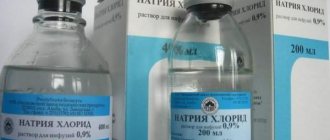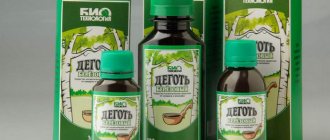Questions, answers, reviews on the drug Acesol
You can look at questions about the drug, as well as ask your question to a specialist, using a free consultation with a pharmacist or pharmacist.
The information provided is intended for medical and pharmaceutical professionals. The most accurate information about the drug is contained in the instructions supplied with the packaging by the manufacturer. No information posted on this or any other page of our website can serve as a substitute for personal contact with a specialist.
| * | Our site does not sell medicines and other goods; they must be purchased in pharmacies, in accordance with current laws. Data on prices and availability in pharmacies is updated twice a day. Current prices can always be seen in the section Searching and ordering medications in pharmacies. |
Similar solutions
If Acesol solution is contraindicated for a patient, the doctor prescribes medications with a similar mechanism of action.
Hlosol
The drug Chlosol, as well as Acesol, is used for intoxication of varying degrees of severity. The medicine thins the blood and prevents acidosis. Chlosol normalizes blood circulation in the capillaries, improves diuresis, and helps the body fight intoxication. The medicine can be prescribed for poisoning due to dehydration. Chlosol is used for diseases such as cholera and dysentery.
The drug contains the same active ingredients as Acesol. Chlosol has contraindications.
- It is not prescribed for allergies to specific components.
- Hyperkalemia is a contraindication.
- It is not recommended to use Chlosol for heart failure.
Rarely, the medicine causes tissue swelling and an increase in potassium levels in the blood. Doses are individual. Before use, the solution is slightly warmed. Chlosol is intended to restore water and electrolyte balance. If there are contraindications for use and adverse reactions, the doctor prescribes Disol. The recommended storage temperature for Chlosol is + 23 degrees.
Trisol
The next similar medicine is called Triol. It contains sodium and potassium chloride. The drug thins the blood, stimulates blood circulation in the capillaries, restores the activity of the cardiovascular system, as well as the kidneys. Trisol is designed to remove toxins from the body. The drug is used for intoxication of varying degrees of severity. It, like Acesol, can be prescribed to a patient who has been poisoned by food.
Popular We relieve pain with Don injections and its analogues
The active substances of the solution protect the body from dehydration and normalize water and electrolyte balance. The medicine is intended for intravenous administration. If an infectious-toxic disease accompanied by blood poisoning is diagnosed, the drug is administered in a stream, followed by a drip. Trisol restores the body after poisoning and dehydration. To prevent acidosis or oliguria, the doctor administers the solution by drop method over 3 hours.
Before use, the drug is heated to medium temperatures. Doses of Trisol are individual. The saline solution normalizes the water balance and replenishes the lack of fluid. If after using the drug the level of potassium in the blood increases, it is replaced with a similar solution. Trisol does not have side effects and also has no contraindications. It is recommended to store it at a temperature of + 23 degrees.
Disol
The medicine is intended for infusion use. Active components - sodium chloride improves blood circulation. Injection water acts as an auxiliary component. Disol is a combined remedy that restores water-salt balance. The medicine, like Acesol, is prescribed for intoxication and loss of large amounts of fluid. It normalizes general well-being in case of dehydration, also ensures the prevention of acidosis and restores diuresis. Indications include excess potassium in the blood and intoxication.
The medicine can be prescribed during pregnancy and lactation. If the patient has impaired renal function, Disol is used with caution. The solution is not prescribed to patients diagnosed with renal or heart failure. During treatment, the doctor monitors the level of electrolytes in the blood.
The drug is intended for intravenous administration. Doses are individual in each case. Before administering the solution, the doctor warms it up. Disol restores the volume of lost fluid. Overdose leads to increased levels of potassium and sodium in the blood. In this case, therapy is carried out, which involves the correction of disorders. Disol can have side effects: tachycardia and swelling.
Lactasol
The drug is used to restore the body after poisoning. It improves water-salt and acid-base balance, replenishes the lack of lost fluid. Lactasol solution contains lactate, as well as potassium, calcium, and chlorine. The drug is intended for intravenous administration. When entering the body, the active components are localized in the extracellular space and inside cells.
There are no contraindications to the drug. Lactasol is intended for intravenous jet or drip administration. If the patient experiences shock due to trauma, about 3 liters of solution is prescribed and administered intravenously. If the drug has a positive effect and improves the patient’s condition, the solution is administered by drop method. Lactasol can be used in severe shock. In this case, it is combined with plasma. Doses are individual, usually 1.5 liters per day.
Popular Elimination of microorganisms during infection with Cefazolin injections
Indication for use is burn pathology. The drug is prescribed for significant burns, when the body is 15% affected, the dosage is from 1 to 3 liters per day. In burn diseases, there is a lack of plasma volume, and the patient's blood pressure is reduced. In this case, the drug is combined with albumin. Lactasol, an analogue of Acesol, is prescribed after peritonitis. The drug is administered for 3 days, combined with blood or plasma. The doctor prescribes a dosage of 2-3 liters per day. Just like Acesol, Lactasol is used for water-electrolyte imbalance. Indications for use are:
- dysentery;
- colitis;
- intestinal paresis.
The dosage is 1.5 per day. Lactasol, separately from other drugs, is used when losing a large amount of blood. The medicine is intended to normalize acid-base and water-electrolyte balance. Indications for use are also compensation of metabolic acidosis. If the acidosis is moderate, the doctor prescribes 500 ml of solution. Deep acidosis requires administration of a larger amount of the drug.
Side effects of the medicine
Just like acesol and its other analogues, the medicine can have side effects. These include weakened immunity, swelling, and allergic reactions. In severe situations, an anaphylactic state occurs. To avoid side effects, the doctor observes the speed of administration of the drug.
If the Acesol solution is administered too quickly, swelling occurs, then symptomatic treatment is prescribed. Side effects associated with fast vision include hyperkalemia. With this disease, muscle weakness appears, paralysis and dysfunction of the cardiovascular system are possible. In severe cases, confusion occurs. In case of such disorders, the doctor stops administration. If a large amount of calcium enters the blood, anorexia develops, nausea, vomiting, and muscle and abdominal pain appear.
If you take Acesol for a long time, you need to monitor the patient's reaction. It is important to promptly identify side effects and monitor plasma electrolyte concentrations. Intravenous use may result in solution overload resulting in pulmonary edema. Lactasol contains sodium ions. If the patient has renal or heart failure, the solution should be taken with caution. Self-treatment is unacceptable!
Lactasol is often prescribed to patients who have contraindications to both Disol and Acesol. The medicine contains many active substances and has a wider spectrum of action. The drug is stored at optimal humidity levels and temperatures up to +25 degrees. Before use, it is warmed up to human body temperature. Now we know what Acesol dropper is for and what analogues this medicine has.
Composition and dosage form
Acesol is available in the form of a sterile solution. The drug is administered only into a vein - in a stream or drip. The solution is completely transparent, packaged in glass or polymer bottles of 200, 400 and 500 ml. Bottles of 100 and 250 ml are sold less frequently.
The main components of Acesol are:
- sodium chloride - 5 g;
- sodium acetate - 2 g;
- potassium chloride - 1 gr.
An auxiliary component is water for injection. Acesol is otherwise called a saline solution; it is isotonic with respect to plasma, and its effect is to replenish the missing fluid.
Indications for use
Acesol has a beneficial effect on metabolic processes in the body and improves the hemodynamic properties of blood. The medicine is widely used for diseases that occur with severe and moderate intoxication, such as:
- food poisoning;
- cholera;
- acute shigellosis (dysentery).
Acesol is given as a dropper to adults when the body is dehydrated and when relieving alcohol intoxication.
In emergency cases, Acesol is used as a drug to replenish blood loss.
The medication can be used for pathologies that involve metabolic disorders and blood thickening. For children, the medication is often prescribed for dehydration caused by vomiting, diarrhea, and febrile syndrome.
Overdose symptoms
Administration of the drug in too large doses or non-compliance with the infusion rate can cause overdose, which is primarily manifested by hyperkalemia. Its development is indicated by arrhythmia, weakness, muscle paralysis, and a sharp drop in blood pressure. If the above symptoms are detected, an analysis is performed and an ECG is performed. Based on the detected changes, treatment with Acesol may be discontinued.
To speed up the normalization of well-being, the patient is prescribed solutions with sodium salts, intravenous administration of Glucose and Insulin.
Hyperkalemia does not always manifest itself with pronounced symptoms, and it is in such cases that a terrible complication most often leads to death.
To prevent this, it is necessary to correctly calculate the dosage and rate of administration of the drug, monitor vital signs during therapy, and periodically repeat tests.
Mechanism of action
The drug is most often used in hospitals and intensive care units. Often, its use begins with the provision of emergency care to patients by ambulance personnel. Acesol has several effects at once, these are:
- detoxification;
- rehydrating (replenishes fluid deficiency);
- plasma-substituting;
- anti-shock;
- antiaggression;
- diuretic.
Once in the bloodstream, Acesol cleanses the blood of metabolites of pathogenic microorganisms, toxins and breakdown products of medications. Under the influence of the medicine, blood microcirculation is activated, metabolic processes are improved, and blood thickening is prevented.
At the same time, diuresis increases, which accelerates the removal of pathogenic elements from the body.
The use of Acesol against the background of hypovolemia reduces the risk of blood clots in large main vessels by 30%.
Potassium and sodium ions, which form the basis of the drug, do not remain in the systemic circulation for long. Leaving the bloodstream, they are distributed in soft tissues, then neutralized by the kidneys and excreted naturally - with urine.
Interaction with other medications
Isotonic solutions cannot be used in conjunction with potassium-sparing diuretics, since this combination of drugs greatly increases the risk of hyperkalemia. In case of severe poisoning and when the volume of circulating blood decreases, Acesol is sometimes used in conjunction with blood substitutes - Poliglyukin, Reogluman, Reopoliglyukin.
If it is necessary to organize parenteral nutrition, Acesol is supplemented with the introduction of droppers with 5% Glucose.
When introducing other medicinal solutions into a bottle with Acesol, it is necessary to visually monitor their compatibility. That is, no sediment or flakes should appear in the liquid, and it should not become cloudy.
You should not drink alcohol-containing drinks during treatment with Acesol. In combination with the active components of the drug, ethanol often leads to angioedema of the subcutaneous tissue and mucous membranes.
Possible adverse reactions
Acesol is a salt preparation that does not cause harm when used correctly. However, you need to know that some people experience side effects that include:
- severe chills;
- tachycardia;
- the appearance of edema.
In most cases, all unwanted reactions occur due to rapid drip administration or incorrectly calculated dosage. Correction of the treatment regimen allows minimizing adverse reactions, so most often Acesol is not discontinued.
Hyperkalemia, an increase in the concentration of potassium in the blood, is considered a serious complication. Subjectively, hyperkalemia manifests itself as abnormal heart rhythm, muscle weakness, decreased amount of urine, vomiting, and convulsions. If such symptoms are recorded, the patient needs to have an ECG and tests for potassium levels. If an increase in the concentration of the microelement is confirmed, Acesol is discontinued and replaced with Disol. Lack of timely treatment for hyperkalemia can lead to respiratory paralysis and cardiac arrest.









